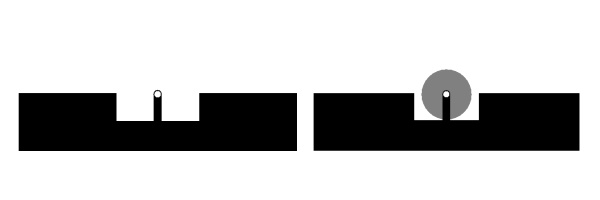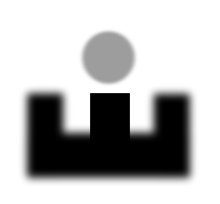Page 1 of 2
Just wondering-why not white sights?
Posted: Fri Jan 06, 2012 10:02 pm
by tedbell
The other post about colored transparent sights motivated me to post about something I've wondered about for a long time, and I throw it out there as more of a philosophical discussion. Why not paint the sights white? If you are trying to stay focused on an object (i.e. the front sight) against a black background (the target), wouldn't it be easier to focus on a white object against a black background as opposed to a black object on a black background? And if you're trying to maintain the front sight centered in the rear sight by monitoring the gap on either side of the front sight (which currently entails focusing on a black sight against a black background while in your peripheral vision monitoring a dark gap between black front and rear sights against a black background), would'nt it be easier (and possibly more precise) to monitor that dark gap if it was framed on both sides by white objects, thus highlighting the gap and making it stand out better (and thus making minute changes in it more apparent)?
Just something I've thought about, and wondered what thoughts the rest of you have about it.
Posted: Fri Jan 06, 2012 10:07 pm
by Richard H
You have a black rear and in theory you're judging the light bars on either side of the front sight. The light bars and the white front sight would be hard to differentiate.
Posted: Fri Jan 06, 2012 11:04 pm
by lxvnrsw
I think most high level shooters use a "6'oclock" hold in which the front sight lies tangent to the very bottom of the black circle of the target, in which the black front sight is technically on the white of the target paper.
People do this just because it's easier to discern precise point of aim, instead of "guessing" just where the center of the black is...
Posted: Sat Jan 07, 2012 12:27 am
by john bickar
A number of years ago, I discussed this with Tim K., an optha-... opto-... eye doctor from "somewhere in the South".
I think a front and rear sight painted dark- to medium-grey could be helpful, especially in low light. Tim concurred, and I seem to remember I took some steps in that direction, but I don't think I ever followed through.
Now might be the time, as I'm getting older and my eyesight is not what it once was.
However, I'm always reminded of Erich Buljung's advice, which was along the lines of "if you're determined not to watch the front sight, you can ignore a white dot just as easily as you can ignore a black front sight." (paraphrased liberally). Newer shooters with good eyesight would do well to heed that advice.
Posted: Sat Jan 07, 2012 1:48 am
by Spencer
lxvnrsw wrote:I think most high level shooters use a "6'oclock" hold in which the front sight lies tangent to the very bottom of the black circle of the target...
most?
it would be interesting to find out for the top 100 on the ISSF ranking for 10m, 25m (Precision Stage) and 50m. Has anybody ever compiled such research?
I would not be surprised if a number answered along the lines of "I'm not sure; somewhere in the white". Moving past any 'discern precise point of aim' to the 'area' concept takes a leap of faith but is a great revelatiuon when achieved.
Posted: Sat Jan 07, 2012 3:31 am
by jackh
My best shooting is when the lighting is just right so I can see the color and texture of the front sight gun metal blue or what ever you call it. When I see the sight that good, I have no idea what is happening at the target. It just seems to work out. The front sight just seems framed by the notch.
Posted: Sat Jan 07, 2012 4:12 am
by David Levene
Spencer wrote:I would not be surprised if a number answered along the lines of "I'm not sure; somewhere in the white".
I'm sure that is right Spencer: what has often been described on TT as "sub-6" or "deep sub-6".
Posted: Sat Jan 07, 2012 7:40 am
by tedbell
It probably also depends on the discipline. For me it's raid fire, which is a center hold in the middle of a very, very large black circle.
Posted: Sat Jan 07, 2012 8:03 am
by william
Why don't you try it and report back to us?
Posted: Sat Jan 07, 2012 8:15 am
by tedbell
william wrote:Why don't you try it and report back to us?
I'm not good enough to be an appropriate test subject. :)
Actually, I have thought about just doing it, painting the sights with some whiteout, but while it would be easy enough to return the front sight to it's original condition after the experiment, I'm concerned it might be hard to clean the rear sight completely and that there will be little flecks of white in the crevices of the rear sight for a long time to come.
Posted: Sat Jan 07, 2012 9:46 am
by David Levene
tedbell wrote:For me it's raid fire, which is a center hold in the middle of a very, very large black circle.
Don't you mean a very, very large grey fuzzy blob?
Posted: Sun Jan 08, 2012 5:25 pm
by tedbell
David Levene wrote:tedbell wrote:For me it's raid fire, which is a center hold in the middle of a very, very large black circle.
Don't you mean a very, very large grey fuzzy blob?
More like a very, very large black fuzzy blob.......... most of the time. ;) Sometimes, admittedly, it's pretty clear. Which is what makes me start thinking about white sights again.
Thanks,
Ted
Posted: Sun Jan 08, 2012 5:36 pm
by Mike M.
I think a lot would depend on the lighting of the firing point. With good light, I think white sights for a center hold would work. In poor light, it wouldn't work, as you can't see the sights.
When I was shooting only U.S. black powder matches (many shot outdoors), I used an orange front sight. Went to black only due to MLAIC rules.
Posted: Sun Jan 22, 2012 12:45 am
by BobGee
Interesting, as I have just “whited” the front post and rear notch on my Margolin to use in Veteran Service pistol. I had my first tryout without doing anything to the pistol and could not see the sights worth a damn against a black duelling target.
I took the “whited” Margo to the range to adjust the front post to raise the aim to centre of target at 25m. Standing on the covered firing point I still had difficulty discerning the sights against a duelling target even though they are now white. It was when I stepped forward into the daylight that the “whited” sights came into their own.
So, it would appear that the type of shooting you want to do and the quality of the lighting at the firing point/line which matter.
For ISSF Standard, Sport or Free Pistol a smoke blackened sight set would be the go whereas Service Pistol, ISSF Rapid Fire and other disciplines of that ilk could benefit from white (or other light coloured) sights, I guess.
Bob
Posted: Sun Jan 22, 2012 11:01 am
by Gwhite
I shoot at a variety of ranges with different lighting. Outdoors there's usually plenty, but many indoor ranges are really dark, especially at the firing line.
I've often wondered if there are rules against wearing a headlight (for example) that would illuminate your sights. It's mostly an issue an issue for the NRA bullseye league I shoot in, but I've had the same issue at some international matches.
Posted: Sun Jan 22, 2012 11:10 am
by Funny Farmer
I tried out a sight with a rather narrow front blade (1,5mm) and a piece of fibreglass attached. With the wide rear sight of my Steyr LP2 the sight picture looked like in the picture below.
It actually worked well, the small light centers itself almost automatically. But I noticed that it makes me concentrate on the center too much instead of an area hold, thus making shot release more difficult. Maybe it is better suited for a top shooter with a more steady hold. Anyway I switched back to standard sights.

Posted: Sun Jan 22, 2012 4:59 pm
by Gwhite
I would think that centering the spot on the black would be very natural However, the front sight is now so far away from the rear sight blade that maintaining good alignment there would be tricky.
Posted: Sun Mar 25, 2012 4:13 pm
by martin
Also tried fiber optic (green) round front sight and half round rear sight with center hold. The idea was that it would be easier for eye to line up 3 circles (well 2 complete circles and one half circle) and didn't work too well. It was hard to center the front sight on the half circle rear sight.
Went back to normal rectangular sights, but painted the front sight florescent green with 6 o'clock hold, and it seems to work very well - much better than the black front sight. Probably just psychological thing, but why not if it "feels" better. :-)
Posted: Sun Mar 25, 2012 7:46 pm
by jackh
I'll say again that the lighting and your vision on the front sight is in my opinion so most important. The sight needs to be seen as the "thing" that you frame in the notch and whatever part of the bull. A blackened silhouette between light bars seems less than ideal to me.
Posted: Mon Mar 26, 2012 3:00 am
by zoned
lxvnrsw wrote:I think most high level shooters use a "6'oclock" hold in which the front sight lies tangent to the very bottom of the black circle of the target...
I think you'll find that holding the front sight tangent to the bull will give you an uncertain vertical displacement. Being that close to the bull creates and optical illusion that allows the outline of the lower edge of the bull to be compressed if you raise the pistol slightly. From my experience there needs to be some white between the top of the post and the bottom of the bullseye.
This image from
http://en.wikipedia.org/wiki/Iron_sight


